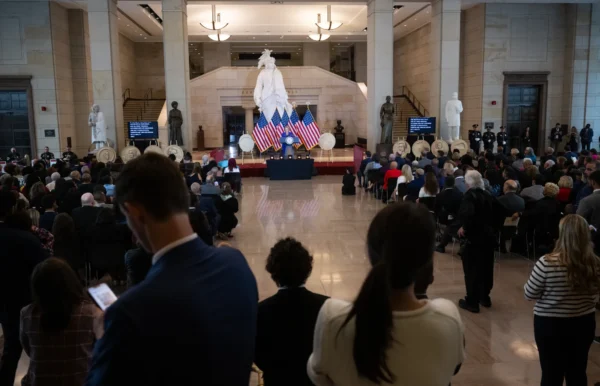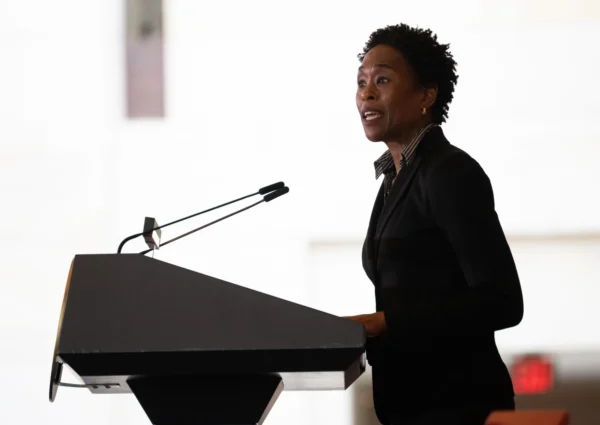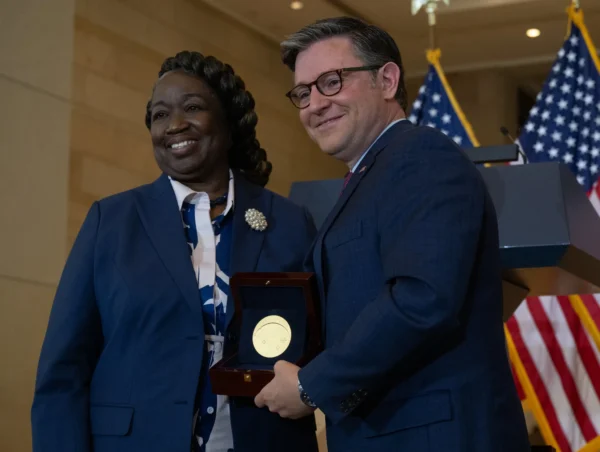Hope native Dorothy Hoover part of Congressional Gold Medal honor
“The pioneers we honor today, these Hidden Figures — their courage and imagination brought us to the Moon. And their lessons, their legacy, will send us back to the Moon,” said NASA Administrator Bill Nelson.
Author Margot Lee Shetterly detailed the stories of the women from NASA Langley in her 2016 nonfiction book “Hidden Figures: The American Dream and the Untold Story of the Black Women Who Helped Win the Space Race.” Though the book focused on NASA Langley, where Shetterly’s father worked, it helped raise awareness of similar stories around NASA.
House Speaker Mike Johnson and Andrea Mosie, senior Apollo sample processor and lab manager who oversees the 842 pounds of Apollo lunar samples. Mosie accepted the medal awarded in recognition of all the women who served as computers, mathematicians, and engineers at the National Advisory Committee for Aeronautics and NASA between the 1930s and the 1970s. NASA/Joel Kowsky
Andrea Mosie, senior Apollo sample processor and lab manager who oversees the 842 pounds of Apollo lunar samples, accepted the medal awarded to all NASA’s Hidden Figures. She began her career at NASA’s Johnson Space Center in Houston in the 1970s.
Mosie thanked Congress for supporting NASA’s campaign to send the first woman and first person of color to the Moon as part of Artemis and the agency’s efforts to provide “opportunities for people, more representative of the way our country looks, to understand humanity’s place in the universe.”
Several NASA Langley officials attended the event to honor the legacies of the women who worked there.
“I am humbled by the significant contributions and lasting impact of these women to America’s aeronautics and space programs. Their brilliance and perseverance still echo not just through the halls of NASA Langley, but through the entire Agency,” said NASA Langley’s Acting Center Director Dawn Schaible. “They are an inspiration to me and countless others who have benefited from the paths they forged.”
Hoover inducted into Arkansas Women’s Hall of Fame
Hoover is 1934 Yerger High graduate and was inducted posthumously into the Arkansas Women’s Hall of Fame in 2023.
Mrs. Hoover was a graduate of Yerger High in Hope in 1934. She graduated when she was 15, then attended Arkansas A.M. & N. (now the University of Arkansas at Pine Bluff). She graduated with a B.S. in Math and then began teaching public school in Newport. Mrs. Hoover worked her way east to Atlanta University and earned a master’s degree in Math. She started working at Langley Labs, NACA (National Advisory Committee for Aeronautics…later NASA). She moved to Ames Laboratory where she became an Aeronautical Research Scientist and was distinguished by her design for “thin sweptback tapered wings” for jets.
Hoover became the first woman to be awarded a master’s degree in physics from the University of Arkansas where she went in 1952. She was studied towards a doctorate in Math from the University of Michigan and after working for the National Weather Service finished her career with NASA’s Goddard Space Flight Center. She passed away in 2000 at the age of 82 in Washington D.C.
Details of her life attracted attention after the book and movie “Hidden Figures” came out and focused on some groundbreaking African American women who worked in the early space program.
Dorothy McFadden Hoover “Hidden Figure” Memorial Endowed Scholarship
In 2022, the Dorothy McFadden Hoover “Hidden Figure” Memorial Endowed Scholarship was established at the University of Arkansas Hope-Texarkana. The $20,000 endowed scholarship was funded by gifts from Ozaree Twillie, Ellen Turner, and donors to the Giving Tuesday 2021 Campaign. The purpose of the scholarship is to provide financial assistance to students pursuing a certificate or degree from the University of Arkansas Hope-Texarkana with preference given to an African American female with a minimum 2.5 GPA. “We are grateful to have this scholarship established in remembrance of Dorothy and to help students follow in her footsteps,” Ozaree Twillie said.
(Additional information on the life of Mrs. Hoover was shared during the announcement of the endowment.)
While Dorothy was finishing her master’s program at Atlanta University, as a result of President Franklin D. Roosevelt’s prohibition of racial discrimination in the national defense industry, Langley Labs, NACA (National Advisory Committee for Aeronautics—later NASA) began hiring African American female mathematicians. Hoover was one of the first of six African American women hired as P-1 mathematicians at Langley. In late 1946, Hoover began working for Frank S. Malvestuto Jr., a brilliant engineer and prolific researcher. Hoover was the primary mathematician for the Stability Analysis Section from 1946 to 1951. By 1951, she had earned the lofty title of Aeronautical Research Scientist. That same year, she was listed as co-author with Malvestuto on two significant research publications addressing “thin sweptback tapered wings” (or jet wings) on aircraft. Being listed as a co-author was a landmark accomplishment. She was the first African American woman to be listed on a Langley engineering report; typically, only white male engineers were listed.
The contributions made by Hoover and Malvestuto had real-world applications in the development of the aeronautical industry in the United States and around the world. This wing design allowed for stable flight at higher and higher speeds. Today, every cargo or commercial jet aircraft utilizes the thin, tapered jet wing, which has become the aeronautical industry standard. It also supports the U.S. Air Force’s long-range B-52 bomber, large C5 cargo plane, and AWACS, a converted Boeing 707. “We are ecstatic that Dorothy is starting to get the recognition she deserves for her professional and academic contributions,” Richard Sallee said. “Her original work in the early 1950s as a co-inventor of the thin, sweptback and tapered (jet) wing forever changed commercial and cargo aviation. This wing technology allowed the aviation industry to become one of the most dynamic industries of the latter half of the 20th century. It is still the wing the aviation industry uses today.”






